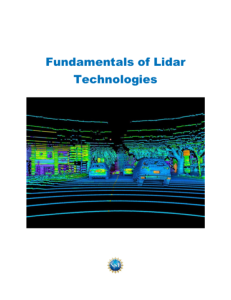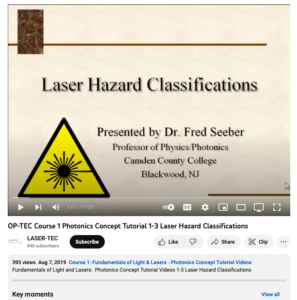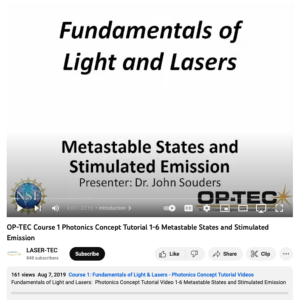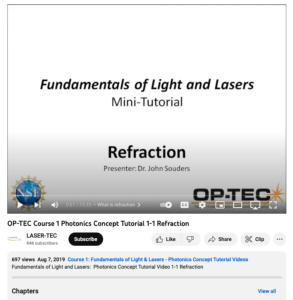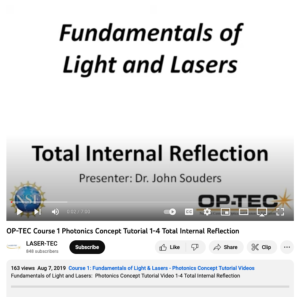Browse Resources
Resources | |
|---|---|
This 45-page resource, from Baker College, is an educational module that provides theoretical knowledge about the growing technology of Lidar. The module includes a laboratory component where students experiment with an industry grade commercial Lidar device and learn hands-on about its features and...
This lecture, presented by Dr. Chrys Panayiotou, covers the basics of diffraction as it relates to the fundamentals of light and lasers. First, Panayiotou defines diffraction (which is the phenomenon caused by interference between waves coming from secondary coherent sources located on the same...
This lecture, presented by Fred Seeber, discusses the basics of laser hazard classifications as the concept relates to the fundamentals of light and lasers. In 17 minutes, Seeber explains the basics of laser hazard classifications, including the ANSI Z136.1 (2000) Standard, and the different classes...
This lecture, presented by John Souders, covers the basics of metastable states and stimulated emission. Souders begins the lecture on the white board, demonstrating equations and charts related to metastable states and stimulated emission. Discussed are concepts such as mechanics, atomics, and...
This lecture, presented by Gary Beasley, covers the basics of optical density as the concept relates to the fundamentals of light and lasers. In 7 minutes, Beasley covers the definition of optical density (a measure of how much light can be transmitted through a specimen or substance), provides...
This lab activity, presented by John Chamberlain, teaches students to measure the power transmitted from a helium neon laser through various colored filters. In the 10-minute video, Chamberlain demonstrates the process by shining a laser through various colored filters, including blue, yellow,...
This lecture, presented by John Souders, covers the basics of refraction as the concept relates to the fundamentals of light and lasers. In 15 minutes, Souders defines refraction (the bending of a light wave when it passes from one medium to another) and describes the conditions necessary for...
This lecture, presented by John Souders, covers the basics of total internal reflection as it relates to the fundamentals of light and laser. In seven minutes, Souders explains the 'critical angle of reflection,' which is "a necessary factor to consider when choosing whether to use dry or oil...
This lab activity, presented by John Chamberlain, covers the basics of windows and mirrors as the two relate to reflections of light. In the 20-minute video, Chamberlain demonstrates equations that help determine reflection, including predicted reflection and actual reflection. Also explored are the...
This 258-page document, published by Natural Resources Canada, provides detailed information on remote sensing. The document is divided into the following chapters: Introduction, Sensors, Microwaves, Image Analysis, Applications, and more. Each chapter includes descriptions, definitions, graphics,...
| |
| ← Previous | Next → |
